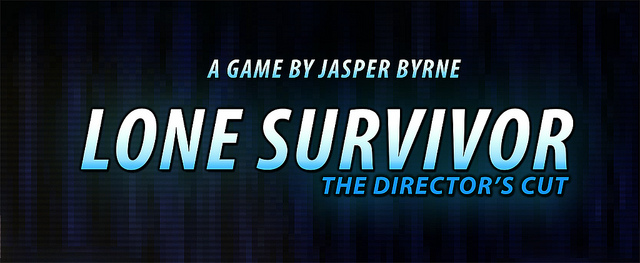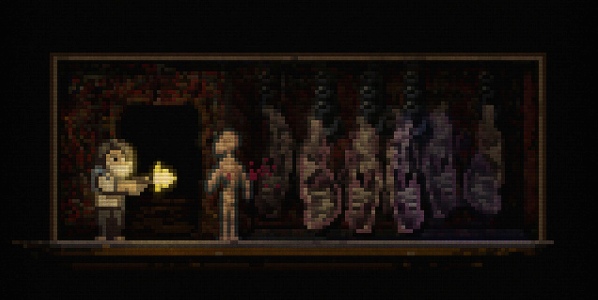
Developer: Superflat Games
Publisher: Curve Studios
Platform: PS3 (Reviewed), Vita
When Lone Survivor originally came out last year on PC I was simply enamored with it. Everything seemed pitch perfect and developer Jasper Byrne, who makes no secret of his affection for Silent Hill, seemed to manage something of equal quality. At least, that’s how I felt at the time. Incredibly, a year can do a lot – such as exposing me to even more modern indie horror experiences. Now that I’ve returned to an updated version does it still hold that same intense appeal? Somehow, it seems my stance has changed. No longer am I simply overwhelmed by the subtle story, visuals, and music. I have become more critical on my second time through.
For those fresh to Lone Survivor, the game focuses around a man who believes himself to be the “lone survivor” of an epidemic. Now, the world is plunged into darkness with creepy monsters wandering around. As it turns out, he is not the only human left but those he meet all seem to have issues of their own – if they’re even real. As you explore, hints of the story are peppered throughout, leading the player to question what is real and what is simply a projection of the protagonist’s mind.

Gameplay plunges right into survival horror’s past to provide an experience that forces you to be very careful with your character’s health. It takes only a few scratches or bites to kill him. As such, you definitely want to avoid enemies whenever possible. This is doable by purposefully placed hiding spots. When utilized properly, you can sneak right by creatures safely. In the beginning, these moments are tense. However, during the second main area of the game there are very few hiding spots to be found. This is not the end game, either! It causes you to have to fight but unfortunately you have to fight a lot.
Of course, just like retro horror games, you aren’t meant to be shooting all the time. Because of this, there are only limited bullets, flares, and the like to aid you in battles (for about half the game). The scarce resources are an issue because of the strange difficulty increase within this large area! Players must shoot with incredible care so as not to waste bullets. It’s true that you can use pills to regain items but these may change the ending received. If I were designing the game, I would reduce enemy encounters tremendously because having them so frequently causes more frustration than fear.
Along these lines of restricted ammo there are also a fairly small amount of food items (again, until a certain point later on). Food is necessary because the survivor needs sustenance regularly. He’ll even stop the game to share the state of his hungry stomach with the player. The intent is cool, but it also becomes a bit annoying if you get into fights too often. Damage can be healed by food, but even if you’re not damaged, you’ll still become hungry. Eating better food allows a longer time between eating but still not as much as might be expected.

Finally, the coup de grace of classic horror is the requirement of saving in a specific way. You must venture back home and sleep in bed to save. Thankfully, saving is unlimited. How can you always get back? There are mirrors which act as warp points throughout the world. It’s a smart design for an overall archaic mechanic. It seems the point of deliberate saving at the bed serves the story, but it would make things a little less frustrating to be able to save at any time. Yes, it’s scary to know you’ve not saved in a while but that becomes annoying when you end up getting killed long after a save.
Even with all these qualms, the rest of Lone Survivor manages to shine. The pixel art looks fantastically crisp on a large TV set as well as on Vita’s OLED screen. Atmosphere was very carefully rendered to keep the game looking creepy, even if gameplay sometimes hinders it. The music itself is as fantastic as ever with a multitude of tracks that seem to hearken back to Akira Yamaoka’s Silent Hill soundtracks. Of course, there are even references back to Silent Hill 2, which certainly made me smile.

What exactly about Lone Survivor: The Director’s Cut is so different from before? For Vita, there are added touch features and PS3 has rumble support. Neither are necessary, but hey. The meatier changes focus on new tracks, areas, side quests, and two new endings. Most of this content is locked behind New Game + though, making it so that everyone will first experience Lone Survivor as it was originally intended. All this added content came at Sony’s request and will eventually make its way back to PC as well.
So when it comes right down to it, Lone Survivor: The Director’s Cut is certainly the definitive edition of the game. However, it has a handful of issues that keep it from being a purely scary experience. Frustration induced by too many enemies, the survivor’s empty stomach, and losing a fair bit of progress to saves, are the main ones. There is also one extended chase scene which is seriously rage inducing to play on Vita as the pause button is in an awkward location (have never liked the Start/Select buttons on the handheld). Still, those who have not played it may still want to give the game a chance. Just be sure to heed my warning: Conserve your resources, save at every possible juncture, and still be prepared for a tough run!

3 out of 5 alpacas
Review code provided
About our rating system